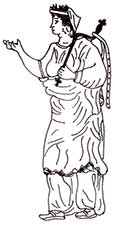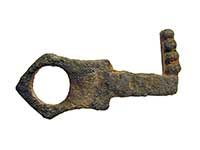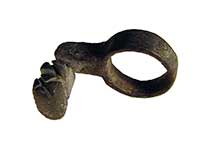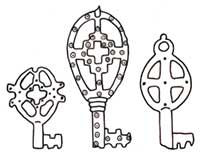Clay tablets from the ancient Babylonian Empire, almost 4,000 years ago, depict keys.
 |
| Greek woman with bronze key on her shoulder. Sketch by the author. |
Keys in Ancient Greece
The Greek word kleis is the root of the French clef. In Ancient Greece, keys were used for temple locks and Spartan locks. Women carried the angular bronze keys on one shoulder. One literary source, Homer, speaks of the key to Odysseus’s storeroom. The Greeks are said to have invented the keyhole, while the Romans refined it.
 |
| Angled bronze key from the Artemis Hemera temple in Lusoi, Arcadia. The inscription confirms that it is a temple key. Length 40.5 cm. 5th century BC. The original is at the Museum of Fine Arts in Boston. Sketch by the author. |
Roman-Era keys
Early Roman keys possessed technical finesse and elegance. They were primarily status symbols for those who had property to protect. Some keys also reflect the architecture of the day, made not only to fit into a lock, but also to look like the door the lock is in.
 |
| Roman key of bronze, circa 3rd C AD. Photo by the author. |
Archaeologists have found many bronze and iron keys in Saalburg, the citadel at the Roman Limes, built to hold off the barbarian invasions. Today Saalburg is a museum 30 km north of Frankfurt am Main in Germany.
 |
| Roman key finger ring of bronze. Photo by the author. |
Another Roman innovation is the tiny key included in a finger ring. Women used keys like this for their jewelry boxes.
Bronze keys from the Migration Age…
European keys in the 6th–9th centuries generally reflect the dominant styles of the era, which makes it relatively easy to determine their age even without access to their locks. Merovingian keys (about 500-750) are more rough-hewn than their predecessors, revealing a regression in craftsmanship. Carolingian keys (about 750-960) usually have a bow shaped like a cross, a bishop’s miter, or other religious symbols.
 |
| 7th-century bronze keys. Sketch by the author. |